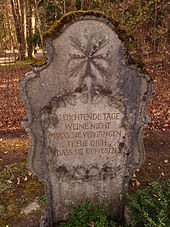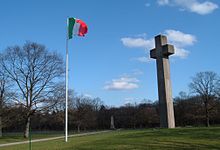Waldfriedhof (Munich)
The forest cemetery in Munich is the first cemetery of its kind in Germany and the largest in the state capital. It is located in the Großhadern district . It is designated as a landscape protection area LSG-00120.16 .
Old part
The concept of creating a cemetery without the strictness of geometric shapes was developed by the then leading cemetery architect and city planning officer, Hans Grässel . In 1905, work began in the former high forest of Fürstenried Castle . Grove-like grave fields were created in the spruce forest, which had already been cleared by using wood. In 1907 the old part of the forest cemetery with 35,000 graves was completed. Today the forest cemetery has a total of 59,000 grave sites on an area of 170 hectares . The city of Munich recently made 40 trees available for eight urn burials each.
The St. Anastasia Chapel is about 300 meters from the main entrance. It was built in 1932 according to plans by the town planning officer Hermann Leitenstorfer . The Munich painter Max Lacher created the frescoes inside.
New part
From 1963 to 1966, the garden architect Professor Ludwig Roemer (1911–1974) expanded the cemetery to include the new section with 24,000 graves. In 1955, Germany's first Islamic grave field was created in the Munich forest cemetery. The Cimitero Militare Italiano with 3,238 Italians who had died was created in 1960 in the new part of the area . Grave field 477 b was created as the New Jewish Cemetery in Munich . It is under the supervision of the liberal Beth Shalom community (Munich) . The Volksbund Deutsche Kriegsgräberfürsorge created the military cemetery on Tischlerstrasse in 1965 with a war memorial to the First World War . It is one of the largest in Germany: 3,543 fallen and victims of the two world wars are buried here. A memorial stone commemorates the 100,000 people who perished after Königsberg was handed over to the Red Army .
On May 25, 1990, at the instigation of then President Heinz A. Staab , the Max Planck Society erected a memorial for the victims of National Socialist euthanasia crimes . The memorial commemorates the numerous victims of the "euthanasia" murders, whose brains were examined by scientists from the Kaiser Wilhelm Institute (KWI) for brain research in Berlin and the KWI for psychiatry in Munich. The preparations from the brains of these victims were buried in the forest cemetery.
Graves
- Monarchs and politicians
- Christoph in Bavaria
- Hans Ehard
- Alfons Goppel
- Georg von Vollmar
- Stepan Bandera
- Alfred von Tirpitz
- a memorial commemorates a group of victims,
- namely to the body parts of victims of the National Socialist euthanasia crimes buried here in 1990 . It calls on scientists to also think about their responsibilities in the future.
- Actors, voice actors and directors
- Leo Bardischewski
- Karl Ludwig Diehl
- Heidi Brühl
- Hansjörg Felmy
- Fritz Kortner
- Karl Schönböck
- Leni Riefenstahl
- Paul Verhoeven
- Elisabeth Volkmann
- Pinka's brown
- Clemens Ostermann
- Singers and composers
- Bernd Aldenhoff
- Karl Amadeus Hartmann
- Max Reger
- Fritz Wunderlich
- Karl Kraft
- Hilde Güden
- Franzl Lang
- Rob Pilate
- Entrepreneur
- Benno Danner
- Jakob Heilmann
- Heinrich Hugendubel
- Hugo Junkers
- Carl Krone
- Michael Schottenhamel
- Friedrich Wamsler
- Artists and architects
- German Bestelmeyer
- Willibald Besta
- Hans Grässel
- Theodor Fischer
- Friedrich von Thiersch
- Karl Stöhr
- Franz von Stuck
literature
- Dagmar Bäuml-Stosiek: A sight for Munich. Graves and graves of famous personalities and changes in the burial culture in the forest cemetery . MünchenVerlag, Munich 2008, ISBN 978-3-937090-33-7 .
- Lioba Betten - Thomas Multhaup: Die Münchner Friedhöfe - Guide to Places of Remembrance , MünchenVerlag, Munich 2019, ISBN 978-3-7630-4056-8 , pp. 54–65
- Hans Grässel : The forest cemetery in Munich , Munich 1907.
- Ludwig F. Fuchs: funerary monuments from the Munich forest cemetery , Munich 1914.
- Georg Jacob Wolf: Munich Forest Cemetery , Augsburg 1928.
- Nina A. Krieg: “Even order is beauty.” Hans Grässel's Munich cemetery architecture (1894–1929), a “German” model? (= Miscellanea Bavarica Monacensia, Vol. 136), Munich 1990, ISBN 3-87821-286-0 .
- Volksbund Deutsche Kriegsgräberfürsorge : War Cemetery Munich-Waldfriedhof , Munich 1963.
- Erich Scheibmayr : Last home - personalities in Munich cemeteries - basic work 1784-1984 , Munich publishing house , Munich 1985, ISBN 978-3-9802211-0-8 .
- Erich Scheibmayr: Who? When? Where? - Supplements to the basic work up to 1989, 1996, 2002 , MünchenVerlag, 3 parts, Munich 1989, 1997, 2002, ISBN 978-3-9802211-1-5 .
Web links
- The forest cemetery on the website of the city of Munich
- Plan of the forest cemetery (PDF file; 930 kB)
- Places of remembrance in Munich - the war cemetery at the Waldfriedhof (PDF; 3.73 MB; from page 62)
Individual evidence
- ↑ ProtectedPlanet official entry
- ↑ Berthold Neff: Memorial against the war. In: www.sueddeutsche.de. April 29, 2018. Retrieved June 8, 2018 .
- ↑ a b c war memorial (moesslang.net)
Coordinates: 48 ° 6 ′ 10 ″ N , 11 ° 29 ′ 37 ″ E







